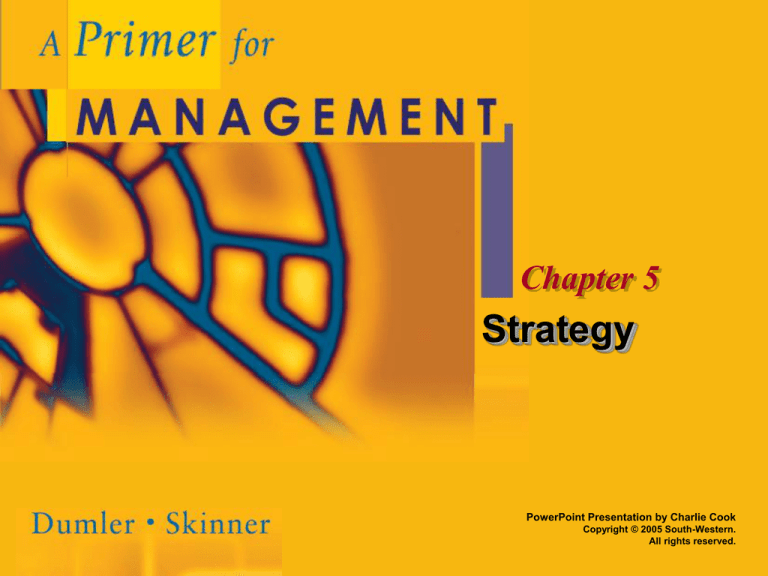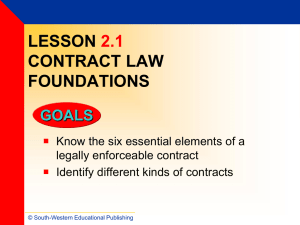
Chapter 5
Strategy
PowerPoint Presentation by Charlie Cook
Copyright © 2005 South-Western.
All rights reserved.
Strategic Planning
• Strategic planning
Developing a strategic orientation for an organization
that culminates in the formulation and implementation
of a multilevel strategy for achieving organizational
goals.
The
process of examining the organization’s
environment, establishing a mission, setting goals and
objectives, and developing an operating plan.
A cyclical process governed by competitiveness,
analysis, and innovation.
Copyright © 2005 South-Western. All rights reserved.
5–2
Strategic Planning (cont’d)
Strategic Planning Process
Exhibit 5 . 1
Copyright © 2005 South-Western. All rights reserved.
5–3
Strategic Planning (cont’d)
• Developing a mission statement
Mission statement answers question: “What is this
organization’s purpose?”
Incorporates the “vision”: values, competencies of the
organization, and future opportunities that create
value for the firm.
• An effective mission statement is:
Customer-focused
Challenging and achievable
Motivational and inspirational
Specific
Copyright © 2005 South-Western. All rights reserved.
5–4
Strategic Planning (cont’d)
Establishing Goals and Objectives
Mission (Strategic Intent)
Long-term Goals
Short-term Objectives
Specific Actions
Copyright © 2005 South-Western. All rights reserved.
5–5
Strategic Planning (cont’d)
• Strategic terminology
Core competencies: activities done well, or skills that
the organization possesses; sources of competitive
advantage.
Distinctive competence: a unique strength that allows
a company to achieve superior efficiency, quality,
innovation, or customer responsiveness.
Competitive advantage: attaining greater profits than
competitors through:
Greater
efficiencies—input and process cost savings.
Differentiation—superior, different products/services.
Copyright © 2005 South-Western. All rights reserved.
5–6
Strategic Planning (cont’d)
Source: Adapted from: Joan Magretta, “Why Business Models Matter” Harvard Business Review, May 2002, pp. 3–8;
Richard Hammermesh, “Making Planning Strategic,” Harvard Business Review, July–August 1986, pp. 3–9; and Henry
Mintzberg, “The Rise and Fall of Strategic Planning,” Harvard Business Review, January–February 1994, pp. 107–14.
Copyright © 2005 South-Western. All rights reserved.
Management Highlight
Strategic Terminology
5–7
Strategic Planning (cont’d)
Quality
Building Blocks of
Competitive Advantage
Innovativeness
Competitive
Advantage
Efficiency
Customer
Responsiveness
Copyright © 2005 South-Western. All rights reserved.
5–8
Strategic Planning (cont’d)
• Strategic terminology (cont’d)
Industry environment: the competition, products,
customers, and any unique characteristics of a
particular industry
Strategic intent: The overall meaning or interpretation
of actions, behaviors, formal communications, and
decisions of an organization’s decision makers
Strategic thinking: The mental ability of a strategic
manager to synthesize competitive implications of
diverse information
Copyright © 2005 South-Western. All rights reserved.
5–9
Strategic Planning (cont’d)
• Strategic terminology (cont’d)
Business model: a description of the organizational
processes an organization intends to use in
conducting a viable business
Business model components:
A narrative
test that sensibly describes what the
organization hopes to accomplish.
A numbers test that projects financial information based
on assumptions about demand and costs that indicate
profitability.
Copyright © 2005 South-Western. All rights reserved.
5–10
Environmental Analysis Process
• Managerial responsibilities:
Providing information and suggestions relating to their
particular areas of responsibility.
Monitoring the process and responding to strategic
planning documents to accomplish their department’s
role in the strategy.
Ensuring that their departments have resources to
support the strategy.
Copyright © 2005 South-Western. All rights reserved.
5–11
Environmental Analysis Process (cont’d)
• SWOT analysis
Strengths—internal resources (core competencies)
that can be used to gain competitive advantage.
Weaknesses—internal resources that are insufficient
to support the firm’s strategy.
Opportunities—external matters that offer the
potential for increased competitive advantage.
Threats—external events that endanger the firm or its
competitive position.
Copyright © 2005 South-Western. All rights reserved.
5–12
Environmental Analysis Process (cont’d)
SWOT Analysis for Starbucks Corporation
Exhibit 5 . 2
Copyright © 2005 South-Western. All rights reserved.
5–13
Environmental Analysis Process (cont’d)
Analyzing the External Environment
Sociocultural
Environment
Competitive
Environment
Technological
Developments
External
Environment
Economic
Conditions
Political
Climate
Copyright © 2005 South-Western. All rights reserved.
5–14
Environmental Analysis Process (cont’d)
• Analyzing the external environment
Sociocultural environment
Environmental
scanning: acquiring and using
information about events and trends in an
organization’s external environment.
Issues management: focusing on a single issue of
strategic importance.
Technological developments
Anticipating
technological changes
Adapting to their implementation in the workplace
Exploiting them for competitive advantage
Copyright © 2005 South-Western. All rights reserved.
5–15
Environmental Analysis Process (cont’d)
• Analyzing the external environment (cont’d)
Economic conditions
The
dynamic economic environment includes:
– Global economic considerations.
– Downward cost pressures.
– Specialization of resources, location, or knowledge.
Political climate
Instability
in governments and laws.
Competitive environment
The
mix of opportunities, constraints, and threats.
Copyright © 2005 South-Western. All rights reserved.
5–16
Environmental Analysis Process (cont’d)
Stakeholder Analysis
Employees
Community
Customers
Stakeholders
Suppliers
Stockholders
Copyright © 2005 South-Western. All rights reserved.
5–17
Corporate-Level Strategy
The Big Picture
Concentration on
a Single Business
Diversification
Corporate-Level
Strategy
Vertical
Integration
Copyright © 2005 South-Western. All rights reserved.
5–18
Corporate-Level Strategy (cont’d)
• The Portfolio Matrix Model
Developed to help large diversified organizations
strategically manage their holdings.
First step in this approach is to identify strategic
business units (SBUs).
Copyright © 2005 South-Western. All rights reserved.
5–19
Corporate-Level Strategy (cont’d)
• Strategic business unit (SBU)
Product or service division within a company that
establishes goals and objectives in harmony with the
firm’s overall mission and is responsible for its own
profits and losses.
Each SBU:
Has
a distinct mission.
Has its own competitors.
Is a single business or collection of businesses.
Can be planned for independently of the other
businesses of the total organization.
Copyright © 2005 South-Western. All rights reserved.
5–20
Corporate-Level Strategy (cont’d)
• SBU classifications
Star—has a high share of a high-growth market.
Cash cow—has a high share of a low-growth market.
Question mark—has a low share of a high-growth
market.
Dog—has a low share of a low-growth market.
Copyright © 2005 South-Western. All rights reserved.
5–21
Corporate-Level Strategy (cont’d)
BCG Portfolio Matrix
Exhibit 5 . 3
Copyright © 2005 South-Western. All rights reserved.
5–22
Corporate-Level Strategy (cont’d)
• Strategic SBU choices:
Build—for stars or potential stars, invest financial
resources.
Hold—for cash cows, hold or preserve market share
to take advantage of their positive cash flows.
Harvest—use when increasing short-term cash
returns is needed for investment in other businesses.
Divest—clearing the portfolio of SBUs with low shares
in low-growth markets is often a good move.
Copyright © 2005 South-Western. All rights reserved.
5–23
Business-Level Strategy
• Porter’s five competitive forces
Threat of new entrants
Threat of substitute products or services,
Bargaining power of suppliers
Bargaining power of buyers
Rivalry among existing competitors.
Copyright © 2005 South-Western. All rights reserved.
5–24
Business-Level
Strategy (cont’d)
Porter’s Five
Forces Model
Adapted from: Michael E. Porter. Competitive
Strategy, New York: Free Press, 1980.
Exhibit 5 . 4
Copyright © 2005 South-Western. All rights reserved.
5–25
Business-Level Strategy (cont’d)
• Porter’s generic competitive strategies
Cost leadership: creating value while maintaining the
competitive advantage of a lower than average cost
structure.
Differentiation: offering a higher-priced product with
more product-enhancing features than competitors’
products to gain and maintain high levels of customer
loyalty.
Focus: creating a niche or target market for products
or services by either cost leadership or differentiation.
Copyright © 2005 South-Western. All rights reserved.
5–26
Business-Level Strategy (cont’d)
Porter’s Competitive Strategies
Exhibit 5 . 5
Copyright © 2005 South-Western. All rights reserved.
5–27
Functional-Level Strategy
Value Chain Analysis
Exhibit 5 . 6
Copyright © 2005 South-Western. All rights reserved.
5–28
Strategy Implementation: McKinsey’s 7-S Model
Exhibit 5 . 7
Copyright © 2005 South-Western. All rights reserved.
5–29
Strategic Planning for the Internet
• Organizations use the Internet in two ways:
To support ongoing (current) business activities.
To conduct a core business activity entirely and solely
on the Internet.
• Criteria for successful e-commerce:
Reach means access—who can access your site?
Richness is a measure of the depth of information
available on the site.
Affiliation concerns who benefits from the site.
Copyright © 2005 South-Western. All rights reserved.
5–30





